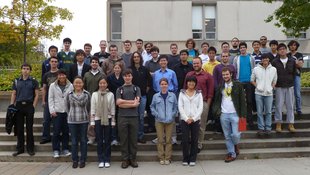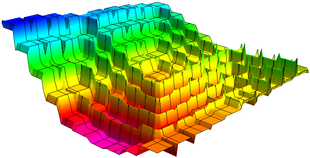|
|
| Line 16: |
Line 16: |
|
|
|
|
|
[http://katlas.math.toronto.edu/drorbn/images/f/f3/10-327-lec06p05.jpg Lecture 6 page 5] |
|
[http://katlas.math.toronto.edu/drorbn/images/f/f3/10-327-lec06p05.jpg Lecture 6 page 5] |
|
|
|
|
|
|
|
|
|
|
|
[[User:D|D]] 12:48, 2 October 2010 (EDT) finite Hausdorff space: The only topology satisfying Hausdorff for a finite set A is the discrete topology; for each distinct point x and y in A, {x} and {y} are disjoint. Also, every finite point set in A is closed. We can check that using the discrete metric on A (d(x,y) = 1 if x =/= y, d(x,y) = 0 if x=y), a sequence of points in A can converge to only one point at most. Also note that Hausdorff condition is stronger than T1. |
Revision as of 12:48, 2 October 2010
| Additions to the MAT 327 web site no longer count towards good deed points
|
| #
|
Week of...
|
Notes and Links
|
| 1
|
Sep 13
|
About This Class, Monday - Continuity and open sets, Thursday - topologies, continuity, bases.
|
| 2
|
Sep 20
|
Monday - More on bases, Thursdsay - Products, Subspaces, Closed sets, HW1, HW1 Solutions
|
| 3
|
Sep 27
|
Monday - the Cantor set, closures, Thursday, Class Photo, HW2, HW2 Solutions
|
| 4
|
Oct 4
|
Monday - the axiom of choice and infinite product spaces, Thursday - the box and the product topologies, metric spaces, HW3, HW3 Solutions
|
| 5
|
Oct 11
|
Monday is Thanksgiving. Thursday - metric spaces, sequencial closures, various products. Final exam's date announced on Friday.
|
| 6
|
Oct 18
|
Monday - connectedness in  , HW4, HW4 Solutions, Thursday - connectedness, path-connectedness and products , HW4, HW4 Solutions, Thursday - connectedness, path-connectedness and products
|
| 7
|
Oct 25
|
Monday - Compactness of ![{\displaystyle [0,1]}](https://wikimedia.org/api/rest_v1/media/math/render/svg/738f7d23bb2d9642bab520020873cccbef49768d) , Term Test on Thursday, TT Solutions , Term Test on Thursday, TT Solutions
|
| 8
|
Nov 1
|
Monday - compact is closed and bounded, maximal values, HW5, HW5 Solutions, Wednesday was the last date to drop this course, Thursday - compactness of products and in metric spaces, the FIP
|
| 9
|
Nov 8
|
Monday-Tuesday is Fall Break, Thursday - Tychonoff and a taste of Stone-Cech, HW6, HW6 Solutions
|
| 10
|
Nov 15
|
Monday - generalized limits, Thursday - Normal spaces and Urysohn's lemma, HW7, HW7 Solutions
|
| 11
|
Nov 22
|
Monday -  and and  , Thursday - Tietze's theorem , Thursday - Tietze's theorem
|
| 12
|
Nov 29
|
Monday - compactness in metric spaces, HW8, HW8 Solutions, Thursday - completeness and compactness
|
| 13
|
Dec 6
|
Monday - Baire spaces and no-where differentiable functions, Wednesday - Hilbert's 13th problem; also see December 2010 Schedule
|
| R
|
Dec 13
|
See December 2010 Schedule
|
| F
|
Dec 20
|
Final exam, Monday December 20, 2PM-5PM, at BR200
|
| Register of Good Deeds
|

Add your name / see who's in!
|

See Hilbert's 13th
|
|
Some blackboard shots are at BBS/10_327-100930-143624.jpg.
|
|
Dror's notes above / Student's notes below
|
|
Here are some lecture notes..
Lecture 6 page 1
Lecture 6 page 2
Lecture 6 page 3
Lecture 6 page 4
Lecture 6 page 5
D 12:48, 2 October 2010 (EDT) finite Hausdorff space: The only topology satisfying Hausdorff for a finite set A is the discrete topology; for each distinct point x and y in A, {x} and {y} are disjoint. Also, every finite point set in A is closed. We can check that using the discrete metric on A (d(x,y) = 1 if x =/= y, d(x,y) = 0 if x=y), a sequence of points in A can converge to only one point at most. Also note that Hausdorff condition is stronger than T1.

![{\displaystyle [0,1]}](https://wikimedia.org/api/rest_v1/media/math/render/svg/738f7d23bb2d9642bab520020873cccbef49768d)



